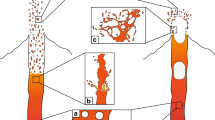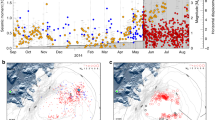Abstract
Intense explosions of relatively short duration frequently precede large explosive and effusive volcanic eruptions—by as much as weeks to months in the case of very viscous magmas1,2,3,4,5,6. In some cases, such pre-eruption activity has served as a sufficient warning to those living in the vicinity to evacuate and avoid calamity1. Precursor events seem to be related to the formation of a magma pathway to the surface, but their precise interpretation is a long-standing puzzle. It has been inferred from theoretical studies that exsolution of volatiles might create an almost separate gas pocket at the tip of a propagating dyke7,8,9. Here we explain the role that such a process may have, using a laboratory study of the transient propagation of a liquid-filled crack with a gas pocket at its tip that grows with time. We show that once the gas pocket acquires sufficient buoyancy to overcome the fracture resistance of the host solid the dynamics of the gas pocket, rather than those of the liquid, determine the velocity of the crack tip. Furthermore, we find that the gas can ultimately separate from the liquid. We propose that fast-moving, gas-rich pockets reaching the surface ahead of the main liquid-filled fissure could be the origin of many precursor eruptions.
This is a preview of subscription content, access via your institution
Access options
Subscribe to this journal
Receive 51 print issues and online access
$199.00 per year
only $3.90 per issue
Buy this article
- Purchase on Springer Link
- Instant access to full article PDF
Prices may be subject to local taxes which are calculated during checkout




Similar content being viewed by others
References
Heiken, G. & McCoy, F. Jr Caldera development during the Minoan eruption, Thira, Cyclades, Greece. J. Geophys. Res. 89, 8441–8462 (1984).
Gardner, J. E., Carey, S. & Sigurdsson, H. Plinian eruptions at Glacier Peak and Newberry volcanoes, United States: implications for volcanic hazards in the Cascade Range. Geol. Soc. Am. Bull. 110, 173–187 (1998).
Newhall, C. G. & Punongbayan, R. S. Fire and Mud: Eruptions and Lahars of Mount Pinatubo, Philippines (Philippine Institute of Volcanology and Seismology, Univ. Washington Press, 1996).
Foxworthy, B. L. & Hill, M. Volcanic Eruptions of 1980 at Mount St. Helens. The First 100 Days. US Geol. Survey Prof. Pap. 1249, 1–125 (1982).
Lipman, P. W. & Mullineaux, D. R. The 1980 Eruption of Mount St. Helens. US Geol. Survey Prof. Pap. 1250, 1–844 (1981).
Young, S. R. et al. Overview of the eruption of the Soufriere Hills volcano Montserrat, 18 July 1995 to December 1997. Geophys. Res. Lett. 25, 3389–3392 (1998).
Barenblatt, G. I. The mathematical theory of equilibrium cracks in brittle fracture. Adv. Appl. Mech. 7, 55–129 (1962).
Lister, J. R. Buoyancy-driven fluid fracture: the effects of material toughness and of low-viscosity precursors. J. Fluid. Mech. 210, 263–280 (1990).
Rubin, A. M. Tensile fracture of rocks at high confining pressure: implications for dyke propagation. J. Geophys. Res. 98, 15919–15935 (1993).
Daag, A. S. et al. in Fire and Mud: Eruptions and Lahars of Mount Pinatubo, Philippines (eds Newhall, C. G. & Punongbayan, R. S.) 409–414 (Philippine Institute of Volcanology and Seismology, Univ. Washington Press, 1996).
Harlow, D. H. et al. in Fire and Mud: Eruptions and Lahars of Mount Pinatubo, Philippines (eds Newhall, C. G. & Punongbayan, R. S.) 285–305 (Philippine Institute of Volcanology and Seismology, Univ. Washington Press, 1996).
White, R. in Fire and Mud: Eruptions and Lahars of Mount Pinatubo, Philippines (eds Newhall, C. G. & Punongbayan, R. S.) 307–327 (Philippine Institute of Volcanology and Seismology, Univ. Washington Press, 1996).
Aspinall, W. P. et al. Soufrière Hills eruption, Montserrat, 1995–1997: volcanic earthquake locations and fault plane solutions. Geophys. Res. Lett. 25, 3397–3400 (1998).
Young, S. R. et al. Monitoring SO2 emission at the Soufriere Hills volcano: implications for changes in eruptive conditions. Geophys. Res. Lett. 25, 3681–3684 (1998).
Mimatsu, M. Showa-Shinzan Diary (Suda-Seihan, Sapporo, Japan, 1995).
Griffith, A. A. The phenomena of rupture and flow in solids. Phil. Trans. R. Soc. Lond. A 221, 163–198 (1920).
Irwin, G. R. Analysis of stresses and strains near the end of a crack traversing a plate. J. Appl. Mech. 24, 361–364 (1957).
Heimpel, A. M. & Olson, P. in Magmatic Systems (ed. Ryan, M. P.) 223–240 (Academic Press, San Diego, 1994).
Rubin, A. M. Dike ascent in partially molten rock. J. Geophys. Res. 103, 20901–20919 (1998).
Einarsson, P. & Brandsdóttir, B. Seismological evidence for lateral magma intrusion during the July 1978 deflation of the Krafla volcano in NE-Iceland. J. Geophys. 47, 160–165 (1980).
Takada, A. Experimental study on propagation of liquid-filled crack in gelatin: shape and velocity in hydrostatic stress condition. J. Geophys. Res. 95, 8471–8481 (1990).
Koyaguchi, T. & Takada, A. An experimental study on the formation of composite intrusions from zoned magma chambers. J. Volcanol. Geotherm. Res. 59, 261–267 (1994).
Foshag, W. & Gonzalez, J. Birth and development of Paricutin volcano. U. S. Geol. Surv. Bull. D 965, 355–485 (1956).
Richard, R. Jr & Mark, R. Gelatin models for photoelastic analysis of gravity structures. Exp. Mech. 6, 30–38 (1966).
Acknowledgements
We thank A. M. Rubin for comments and D. L. Sahagian. We also thank A. Agnon and C. Jaupart for discussions and G. Bienfait for help with experiments.
Author information
Authors and Affiliations
Corresponding author
Rights and permissions
About this article
Cite this article
Menand, T., Tait, S. A phenomenological model for precursor volcanic eruptions. Nature 411, 678–680 (2001). https://doi.org/10.1038/35079552
Received:
Accepted:
Published:
Issue Date:
DOI: https://doi.org/10.1038/35079552
This article is cited by
-
In situ tensile fracture toughness of surficial cohesive marine sediments
Geo-Marine Letters (2012)
-
Kimberlite ascent and eruption
Nature (2007)
-
Wilson & Head reply
Nature (2007)
-
Burrow extension by crack propagation
Nature (2005)
Comments
By submitting a comment you agree to abide by our Terms and Community Guidelines. If you find something abusive or that does not comply with our terms or guidelines please flag it as inappropriate.



